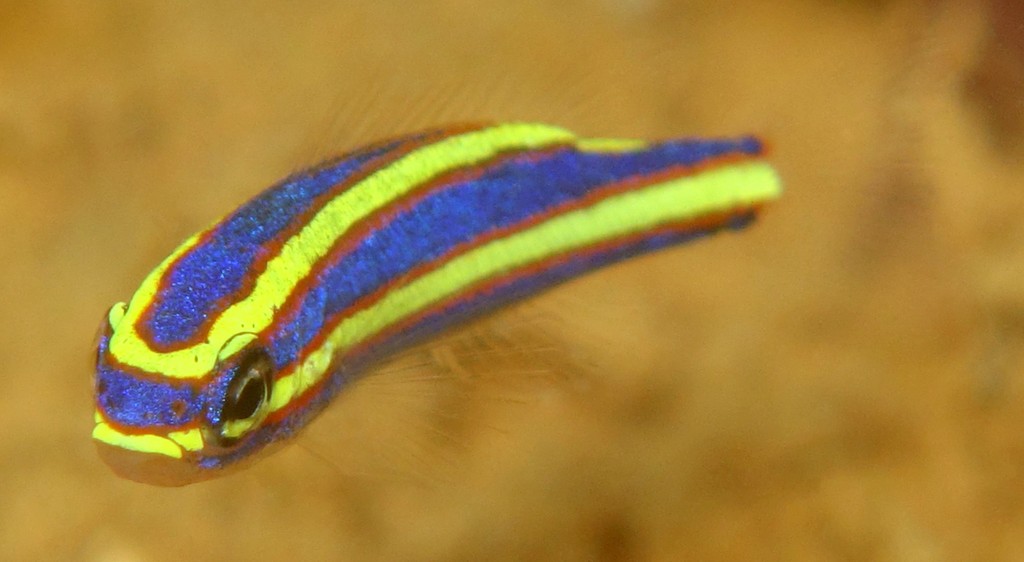PENTAPODUS AUREOFASCIATUS - (RUSSELL, 2001)
Picture courtesy of: Alain Daoulas
Pentapode à deux lignes d’or, Pentapode à bande jaune, Yellow-striped whiptail, Yellowstripe threadfin bream, Yellowstripe whiptail, Yakushimakitsuneuo, ヤクシマキツネウオ,
Description
Dorsal spines (total): 10-11; Dorsal soft rays (total): 8-9; Anal spines: 3; Anal soft rays: 7; Pectoral fin rays: 16-17; Pelvic fin rays: I, 5; Pored lateral line scales: 42-48 (usually: 46-47); Transverse scale rows above lateral line: 3, below: 11; Transverse scale rows on preopercle: 3-5 + 3; Body depth: 3.6-3.7 in SL; Head length: 3.5-3.6 in SL; Snout: 3.2-3.4 in Head Length; Eye diameter: 3.3-3.4 in Head Length, 1.0-1.1 in snout length; Interorbital width: 2.8-3.0 in Head Length; Suborbital depth: 8.1-8.9 in head length; Caudal peduncle depth: 2.2-2.5 in caudal peduncle length; Dorsal fin base length: 1.9 in SL; Fourth dorsal fin spine longest: 2.0-2.1 times length of first dorsal fin spine; Sixth dorsal fin soft ray longest: 0.8-0.9 times length of longest dorsal fin spine; Anal fin base length: 6.1 in SL; First anal fin spine: 1.9-2.1 in length of second anal fin spine; Second anal fin spine: 1.3-1.4 in length of third anal fin spine. Head scales not reaching forward dorsally to a line between posterior nostrils; Lower limb of preopercle scaly; Posterior tip of depressed pelvic fin just short of level of anus; Caudal fin forked, without filamentous extensions, upper and lower lobes subequal in length. Max. length: 25.0 cm TL. Depth range: 5 - 35 m.
Color
- 4.0 cm TL juveniles had a deep purplish blue head and body with two brown-edged bright yellow stripes, the uppermost of the latter extending on each side from the upper part of the caudal peduncle over the eye to above the anterior eye margin, thereafter joining in the dorsal midline on the head. The width of the stripe was narrower than the pupil diameter, that part of the stripe above the eye being the narrowest. The lower bright yellow stripe ran from the tip of the upper lip to the anteroventral margin of the eye, and from the posteroventral margin of the eye through above the pectoral fin base to the middle of the posterior margin of the caudal-fin base. The posterior part (posterior to eye) of the lower strip was wider than both the anterior part (anterior to eye) and the upper stripe. The widest part of the lower stripe, between the pectoral and anal-fin bases, was subequal to the pupil diameter. The eye, except for the black pupil, was usually bright yellow. All fins were transparent.
- Juveniles gradually became brownish dorsally and bluish-white ventrally with growth. The anterior portion of the upper yellow stripe (above anterior margin of eye) disappeared at 15.0 cm TL, the anterior portion of the lower yellow stripe (anterior to eye) also being lost at ca 25.0 cm TL. With the exception of the nuptial colored males, the caudal fin coloration of live Pentapodus aureofasciatus was always transparent or translucent throughout life.
- Nuptial colored males were clearly distinct from normal colored adults, subadults and juveniles. Head and body yellowish-green dorsally and yellowish-white ventrally, with three blue stripes; The first stripe from posterodorsal margin of eye to a vertical through anal fin origin, the second from above upper lip to anterior margin of eye and subsequently from posterior margin of eye to caudal peduncle, the third from below lower lip passing below eye to opercular margin; Caudal fin reddish on upper lobe and upper part of lower lobe, remaining lower lobe and posterior margin of fin translucent; Yellow stripe absent (replaced by second blue stripe).
Etymology
Pentapodus: from ancient Greek, pénte = five + from Greek, podus or podos = feet. According to Valenciennes (1835), who called the genus “Pentapus,” referring to three long, pointed scales, one above root of each ventral fin and a single one between them, appearing like five ventral fins.
aureofasciatus: from Latin, aureus = golden; gold + from Latin, fascia = stripe + from Latin suffix, inus = pertaining to. Referring to distinctive yellow mid-lateral band.
Original description: Pentapodus aureofasciatus Russell, 2001 - Type locality: Tutuila Island, American Samoa, 14°18'S, 170°42'W (Fagatogo market).
Distribution
Western Pacific: Brunei and Malaysia, east to Caroline Islands (Micronesia), Solomon Islands, Tonga, Samoa and Fiji, north to southern Japan, south to Queensland (Australia) and New Caledonia.
Biology
Inhabits coral reef and sandy bottom areas. Solitary or small groups in rubble areas.
Similar species
- Pentapodus berryae (Allen, Erdmann & Brooks, 2018) - Reported from Western Pacific: East Cape area, Milne Bay (Papua New Guinea).
- Pentapodus caninus (Cuvier, 1830) - Reported from New Caledonia - Link to the species (here) - Juvenile have gold lines reaching the nose.
- Pentapodus emeryii (Richardson, 1843) - Reported from Eastern Indian Ocean and western Pacific: Brunei, Malaysia and Indonesia, east to Philippines and New Ireland (Papua New Guinea), south to northern Western Australia. The difference is with the width of the stripes. The Pentapodus aureofasciatus has stripes of equal size on back and side. The Pentapodus emeryii has a wider mid-lateral stripes.
- Pentapodus komodoensis (Allen & Erdmann, 2012) - Reported from Eastern indian Ocean: Komodo (Indonesia) endemic.
Last update: 12, October 2024
